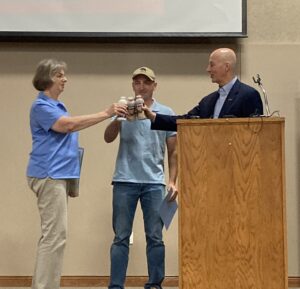AFAN, along with our partner organizations, want to take this opportunity to give our full support for poultry barns like the one proposed in Lancaster County. Livestock, including poultry, are the perfect complement to raising grain and Nebraska is a great place for both to thrive. Nebraska is a top producer of both corn and soybeans, both essential livestock feeds. From an economic standpoint, it makes sense for producers to expand livestock operations close to where these inputs are grown.
As a result, livestock expansion is a critical part of sustaining and growing Nebraska’s rural communities. This proposed poultry barn project would create jobs, diversify the local agriculture economy and provide another market for grain as feed. Perhaps most importantly, it will ensure a local family is able to provide for themselves and potentially make plans for the next generation that may want to return to Lancaster County and work in agriculture.
We would like to share some facts, based on research and science to help neighbors understand the proposed project. Below we will outline some of the major issues and benefits of Randy Essink’s proposed poultry barn project.
- Economic impact
Based on Nebraska Public Power District study, that looked at expanding poultry production in the state one can begin to see the potential economic impact a four-barn project like the one proposed here would have on Lancaster County. Per this study, best guess estimates this project and its multiplier effect in the county would provide:
+3 direct/indirect jobs
+$300,000 direct/indirect labor income
+$16,000 direct/indirect local property taxes annually
- Environment
Lancaster County’s own conditional use permit process and regulations set by the Nebraska Department of Environmental Quality will also closely monitor the practices used by the Essink family to ensure they
are protecting the environment. This poultry operation will use a nutrient management plan that will guide the land application of the waste from the poultry barns. They will be required to follow best management practices to minimize odor, dust and other potential impacts to air and water.
- Property Value of existing homes in the area
Different projects have different impacts and the impact to neighboring property values can decrease, but they can also increase too. Today’s livestock and poultry buildings are more environmentally responsible than ever before. Farmers and ranchers employ the best available technologies for dealing with both waste and odor. These things help ensure a better quality of life for rural Nebraska, and for generations to come.
AFAN has completed some of our own research surrounding valuations of properties near existing livestock operations in the area. In particular, we have detailed our findings related to the most similar site in the area, a 5 barn egg laying farm on the Lancaster/Gage County Line Southeast of Firth.
People have felt so comfortable there are several instances of new construction surrounding this layer farm. There is overall generally positive growth in property values no matter the size or location of a home. And any decrease seems likely related to the age and quality of the home.
- Road Safety and traffic
Road safety is very important to livestock producers. They want to make sure that their families, employees, animals and anyone who visits their farm travels to and from safely. Here are some steps that livestock producers take to assure safety and minimize the impact of the roads: covering manure trucks, proper signage, improvements to ingress/egress for trucks to turn and maneuver easily and scheduling of trucks to avoid commuter schedules.
- Odor Footprint
Country living means living near agriculture. And with agriculture comes some odor. Nebraska farmers and ranchers do what they can to mitigate odor, but we cannot eliminate it all. That’s why agriculture is located in the country! Poultry farmers take several steps to reduce the odor from their barns and land application of litter. Here are a few examples:
1. Barns with solid walls
2. Fans and a filter system for the barns
3. Manure is removed only a few times a year
4. Consideration of weather, time of day and wind speed prior to land application.
In addition, UNL’s odor footprint tool can help individuals evaluate the impact that the farm will have on the area. AFAN ran this tool in relation to the proposed poultry barn project in Lancaster County and found that at ¼ of a mile odor should not be an issue 95% of the time. When increased to ½ a mile it is closer to 99% odor free.
- Straight From the Farmer – Randy Essink
“We like the location. We like the seclusion. You can’t see any neighbors, there’s trees all around the property and we’re really excited about it,” said Essink.
Essink is looking forward to being one of the newest growers for Costco. This project will allow him to quit his current off-farm job that requires extensive travel and work on-farm raising poultry to provide for his family.

